ZZ, short for Zanzibar or Zamioculcas zamiifolia, are popular plants among indoor gardeners. With close to no maintenance required, ZZ plants offer several benefits.
Their ability to thrive in dry conditions, however, doesn’t immunize them against underwatering. ZZs typically require watering only once a month or twice. However, they wish to be completely dried out between waterings.
This makes for one potential cause of dried-up, underwatered ZZ plant. What other signs are there?
Table of Contents
How to Tell If My ZZ Is Underwatered?
The ZZ plant is extremely hardy so it doesn’t show signs of being underwatered easily. ZZ plant leaves may start to yellow and dark or light brown spots may appear if it’s underwatered. The leaves also look droopy and hang lower than usual. Dry leaves start falling away in later stages.

5 Symptoms of Underwatered ZZ Plants
Due to the ZZ’s hardiness, it might not be easy to notice signs of water stress until your plant is already beginning to suffer. If you don’t water it, it will deteriorate and eventually die.
Despite this, other variables are present. Your ZZ plant may get dehydrated for a variety of reasons, including the season and its location in your house.
1. Yellowing Of the Leaves
The ZZ plant leaves turn yellow when it needs a nice drink, just like Daylilies leaves turn yellow.
Yellow leaves are being sacrificed so that the rest of the plant can survive as your plant gathers its resources.
Your plant is in self-pilot mode, and getting it back to normal will take time.
Look for yellowing at the tips of the ZZ. It usually starts there.
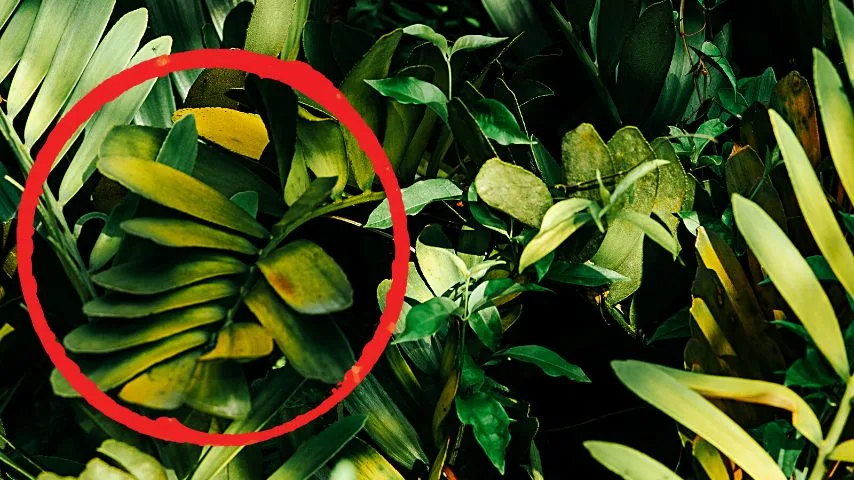
Along with this yellowing, your ZZ may turn fragile, crispy, and dry. This is the height of underwatering – your plant is calling out to you.
2. Dark and Light Brown Spots
If severely underwatered, your ZZ’s leaves will start drying out, dying in the process. Keep an eye out for crispy spots, particularly on the upper leaves.
Dry soil and lack of water can lead to the development of these dry, dark, and light brown spots.
Once the chlorophyll of the leaves starts to dissipate, you will want to remove the dead parts of the leaves as well.
If necessary, prune entire leaves so that there are no dead and unhealthy parts on the plant. Simply use a clean and sharp knife or a pair of pruning shears.

3. Droopy, Sagging ZZ Plant
When your ZZ plant’s dehydrated, it sags. It is somewhat similar to hydraulics, where the water in your plant’s vascular system helps keep it upright. Your plant will sag if that extra support isn’t provided.
The droopiness takes a drastic start when you have missed more than four waterings. Mostly, owners try to avoid overwatering their ZZs, and in doing so, they end up underwatering them.
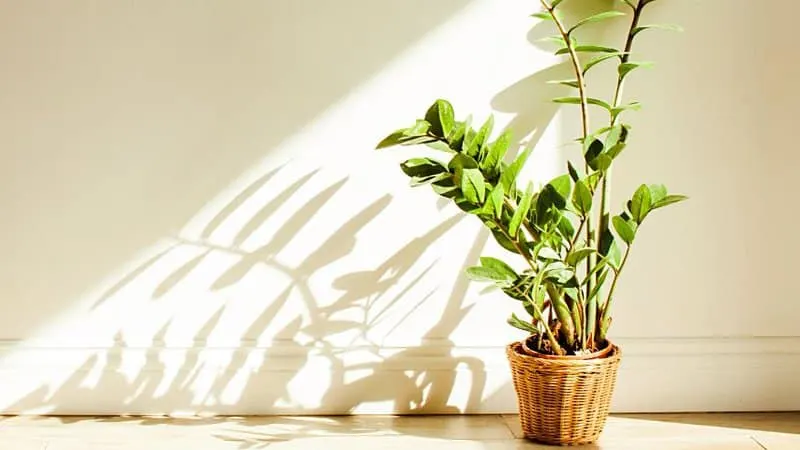
With too much sun and not enough water, the plant won’t have enough of its nutrients to stay healthy and upright.
If your ZZ is drooping and sagging, it means it is high time that you watered it.
4. Brown Leaf Tips
Your plant is in trouble if it starts to brown. Since the leaf’s tip is most susceptible to environmental changes, any neglect to keep your ZZ plant well-watered will become apparent here.
The resources can’t get to the leaf tips when there is a water shortage. Therefore, soon, the leaf tips will turn brown.
It starts with yellowing. Because the tips of leaves are the last part of a plant to receive water, the discoloration manifests here first.
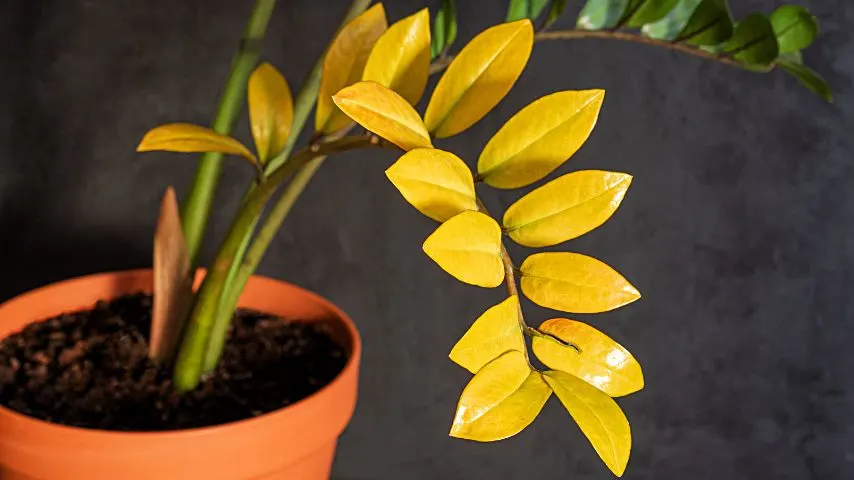
Yellow tips alone should be indicators enough that your ZZ plant is underwatered. However, if it goes beyond yellow, the brown leaf tips should then signify an immediate, urgent need for watering.
5. Dry Leaves Falling
If there is not enough water, even a healthy, green leaf will begin to show indications of damage.
Despite otherwise being lush and robust, the leaves on your ZZ plant start to appear crispy and brown, as if they have been burned around the edges.
Your ZZ plant is seriously underwatered if it loses its brown-edged leaves. Your indoor ZZ plant will also employ this strategy when thirsty. Wild ZZ plants lower their leaves to preserve water during droughts.
Saving an Underwatered ZZ Plant
ZZ plants normally need to be watered once a month during the winter or in low light conditions and twice a month in the spring and summer.
Semi-succulent ZZ plants do well in soil that drains properly. Between waterings, they prefer to dry out totally.
Using a probe to measure the plant’s root-level moisture before watering helps each time.
Fortunately, underwatering your ZZ plant will probably not do too much harm and is simple to fix.
Your ZZ develops from the fleshy rhizomes that are responsible for storing both nutrients and water very effectively, making it a specialist in the desert.
Considering that all plants require water, here are the measures that have been discovered to help you rehydrate your dried-out ZZ and give it a full, luscious life.
Follow the steps below.
1. Removal of Severely Damaged Leaves
With clean, precise shears, gently remove any damaged leaves. Green leaves with a hint of crispness at the tips or edges can be left alone, but anything that has turned yellow must be removed.
Simply cut them off. Then, your ZZ plant concentrates on renewal.
It is not just dehydration — cutting away leaves will save your plant from many other pests.
2. Evaluate Your ZZ’s Pot and Soil
Check the quality of your ZZ plant’s soil as well as the pots you’re using. Indoor plants benefit from being planted in a pot with good drainage, but it is also possible to have too much of what’s considered a good thing.
If the soil you’re using isn’t retaining water and it dries quickly, it’s a good idea to re-pot.
The pot used to grow your ZZ plant may also be a culprit of the problem.
Compared to unglazed ceramics or terracotta pots, plastic pots are better in terms of retaining water.
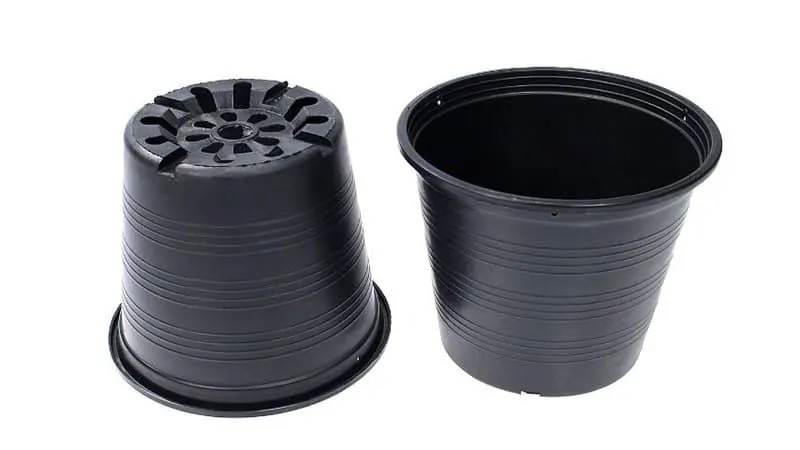
Terracota pots or unglazed ceramics are porous materials that allow for evaporation of the water deep into the soil.
If repotting your ZZ plant is what you’re planning to do, get a pot that has almost the same size, with no more than 1-2 inches difference across from the old pot.
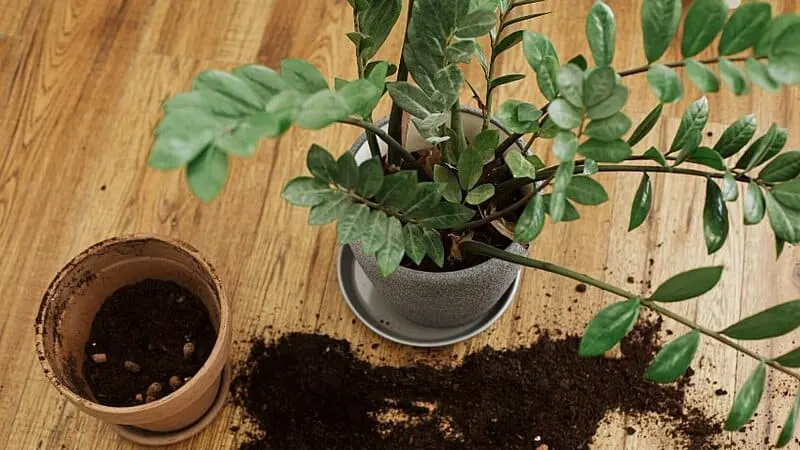
3. Watering From the Bottom
It is time to water after you’ve finished your surgery, if necessary, and make sure your ZZ plant is in the proper container with decent potting material.
Watering your ZZ plant from the bottom is the most effective way of watering it. This method stops surface evaporation and delivers water to the roots.
Frequently Asked Questions About Underwatered ZZ Plant
What’s The Best Watering Schedule For My ZZ?
ZZ plants benefit from some degree of neglect. Even in the height of the growing season, they don’t use much water because they are slow-growing plants with minimal water requirements. Generally speaking, if you check your plant and don’t overwater, once every week or two should be sufficient.
How Much Light Does My ZZ Require?
Your ZZ plant will lose moisture in the heat of the sun, heated air, and air conditioning atmospheres. Bright lights don’t aren’t exactly healthy for ZZ plants, so keeping them shaded will not only help keep their soil hydrated for longer but will also help keep the plant from becoming stressed.
Is My ZZ Underwatered?
Many of the symptoms of a poorly hydrated ZZ plant are also present in poorly watered ZZ plants. If your ZZ has brown leaf tips and yellow leaves, crispy-edged leaves, and curled, wrinkled leaves that are drooping or wilting, your ZZ is severely underwatered.
Conclusion About Underwatered ZZ Plant
If a ZZ plant is underwatered, it will develop yellow foliage as well as brown to black spots on the leaves. The leaves will start to look droopy and will start to fall off. To remedy the situation remove wilted and damaged leaves, check the pot and potting soil and water the ZZ plant from the bottom.

Daniel has been a plant enthusiast for over 20 years. He owns hundreds of houseplants and prepares for the chili growing seasons yearly with great anticipation. His favorite plants are plant species in the Araceae family, such as Monstera, Philodendron, and Anthurium. He also loves gardening and is growing hot peppers, tomatoes, and many more vegetables.


